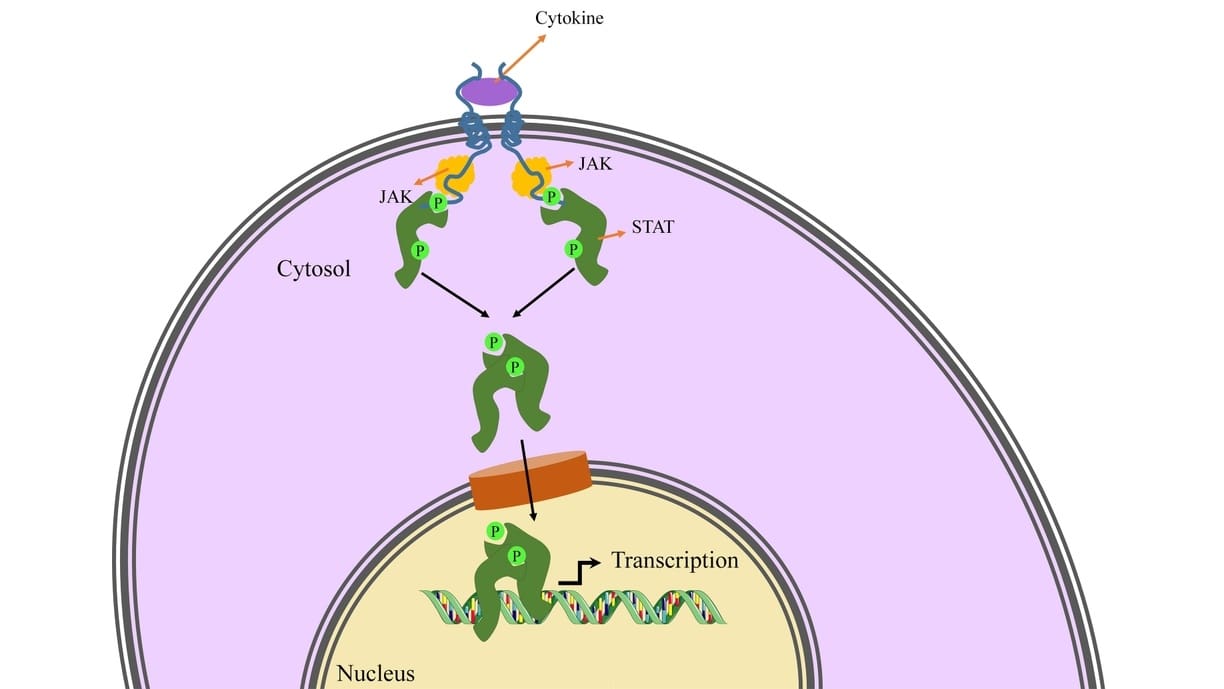Janus kinase (JAK) is a family of intracellular nonreceptor tyrosine kinases which transduce cytokine-mediated signals via the JAK-STAT pathway. They were initially named as “just another kinase” 1 and 2. Later on, they were named as Janus kinase. JAKs possess two near identical phosphate-transferring domains. One domain exhibits the kinase activity, while the other negatively regulates the kinase activity of the first.
Table of Contents
1. Janus Kinase (JAK)
There are four family members of JAK:
- Janus kinase 1 (JAK 1)
- Janus kinase 2 (JAK 2)
- Janus kinase 3 (JAK 3)
- Tyrosine kinase 2 (TYK 2)
JAK 1 and JAK 2 are involved in type II interferon (interferon-gamma (γ)) signalling, while JAK 1 and TYK 2 are involved in type I interferon signalling.
Functions
Some members of type I and type II cytokine receptor families possess no catalytic kinase activity; they rely on the JAK family of tyrosine kinases to phosphorylate and activate downstream proteins involved in their signal transduction pathways. The receptors exist as paired polypeptides, thus exhibiting two intracellular signal-transducing domains.
JAKs associate with a proline-rich region in each intracellular region that is adjacent to the cell membrane. After the receptor associates with its respective cytokine/ligand, it goes through a conformational change, bringing the two JAKs close enough to phosphorylate each other. The JAK autophosphorylation induces a conformational change within itself, enabling it to transduce the intracellular signal by further phosphorylating and activating transcription factors. The activated factors dissociate from the receptor and form dimmers before translocating to the cell nucleus, where they regulate the transcription of selected genes. Some examples of molecules using the JAK/STAT signalling pathway are a colony-stimulating factor, prolactin, growth factor and many cytokines.
Clinical Significance
JAK inhibitors are under development for the treatment of psoriasis, rheumatoid arthritis, polycythemia vera, alopecia, essential thrombocytopenia, ulcerative colitis, myeloid metaplasia with myelofibrosis and vitiligo.
2. Stat Protein
Members of the signal transducer and activator of transcription (STAT) protein family are intracellular transcription factors which mediate many aspects of cellular immunity, proliferation, apoptosis and differentiation. They are primarily activated by membrane receptor-associated Janus kinases (JAK).
Dysregulation of the JAK-STAT pathway is frequently observed in primary tumours and leads to increased angiogenesis which enhances the survival of tumours and immunosuppression. It is known that STAT proteins are involved in the development and function of the immune system and play a role in maintaining immune tolerance and tumour surveillance.
The first two stat proteins were identified in the interferon system. There are seven mammalian STAT family members that have been identified: STAT 1, STAT 2, STAT 3, STAT 4, STAT 5 (STAT 5A and STAT 5B ) and STAT 6.
Activation
Extracellular binding of cytokines or growth factors induces activation of receptor-associated Janus kinases, which phosphorylate a specific tyrosine residue within the STAT protein promoting dimerisation. The phosphorylated dimer is then actively transported to the nucleus via an importin α/β ternary complex. Once STAT reaches the nucleus, it binds to a consensus DNA-recognition motif called as gamma-activated sites (GAS) in the promoter region of cytokine-inducible genes and activates transcription. The STAT protein can be dephosphorylated by nuclear phosphatases, which leads to the inactivation of STAT and subsequent transport out of the nucleus.
JAK-STAT Signalling Pathway
The pathway transmits information from extracellular chemical signals to the nucleus resulting in DNA transcription and expression of genes involved in immunity, proliferation, differentiation, apoptosis and oncogenesis. The signalling cascade consists of three main components: a cell surface receptor, a Janus kinase (JAK) and two Signal Transducer and Activator of Transcription (STAT) proteins. Disrupted or dysregulated JAK-STAT functionality can result in immune deficiency syndromes and cancers.
Mechanism of JAK-STAT
The binding of various ligands, like cytokines, interferon, interleukin and growth factors to cell surface receptors, activate associated JAKs, increasing their kinase activity (Fig. 1.1). Activated JAKs then phosphorylate tyrosine residues on the receptor, creating binding sites for proteins possessing SH2 domains. SH2 domains containing STATs are recruited to the receptor where they are also tyrosine-phosphorylated by JAKs. These activated STATs form hetero- or homo-dimers and translocate to the cell nucleus where they induce transcription of target genes. STATs may also be tyrosine-phosphorylated directly by receptor tyrosine kinases, such as epidermal growth factor receptors, as well as by non-receptor (cytoplasmic) tyrosine kinases.

The pathway is negatively regulated on multiple levels. Protein tyrosine phosphatases remove phosphates from cytokine receptors and activated STATs. Suppressors of Cytokine Signalling (SOCS) inhibit STAT phosphorylation by binding and inhibiting JAKs or competing with STATs for phosphotyrosine binding sites on cytokine receptors. STATs are also negatively regulated by Protein Inhibitors of Activated STAT (PIAS), which act in the nucleus through several mechanisms.
Janus kinase inhibitors, a type of Janus kinases-blocking drugs are used for cancer therapy.
Make sure you also check our other amazing Article on: Kinetics of Drug Elimination
